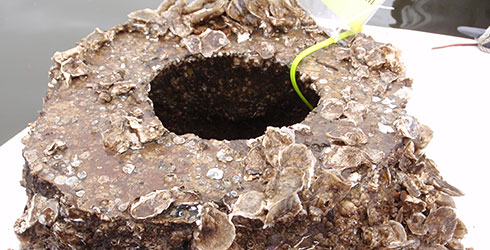
The restoration of a variety of ecological systems located within the NY/NJ region is supported by a wide range of Federal, State, and non-governmental organizations (NGOs). Restoration of bivalves and subtidal habitat is a particularly important goal that contributes to improving water quality and supports commercially important fin fish and invertebrate species, while offering protection to vulnerable coastal shorelines and wetlands.
Oyster Restoration
In the brackish marsh ecosystem of the Hudson-Raritan Estuary (HRE), Eastern Oysters (Crassostrea virginica) were historically "Keystone Species", or ecological engineers. Although today ecologically extinct from the HRE, continuing water quality improvements support reintroducing oysters to the estuary. The U.S. Army Corps of Engineers draft HRE Comprehensive Restoration Plan (2009) calls for establishing 200 acres of oyster reef by 2020. CUES and NY/NJ Baykeeper have been collecting HRE oyster survival and growth data since 2006 and in 2013 will establish a 1/4-acre Raritan Bay restoration research test site at Naval Weapons Station Earle (NWSE).
Oyster Restoration Survey
In 2011-12 CUES and NY/NJ Baykeeper lead Citizen-Scientist volunteers in mapping over 30 miles of Raritan Bayshore to determine sites that might one day support oyster reintroduction. Twenty-three parameters were recorded and data was collect every 100 meters. An Oyster Restoration Index Score was calculated for all sampling locations and used to create the Oyster Restoration Survey Map. This map is the first attempt in the HRE to focus reintroduction toward locations that may have a high chance for success, and eliminate sites that are unsuitable. Further scientific vetting is needed before any of these locations could be considered for long-term oyster restoration.


